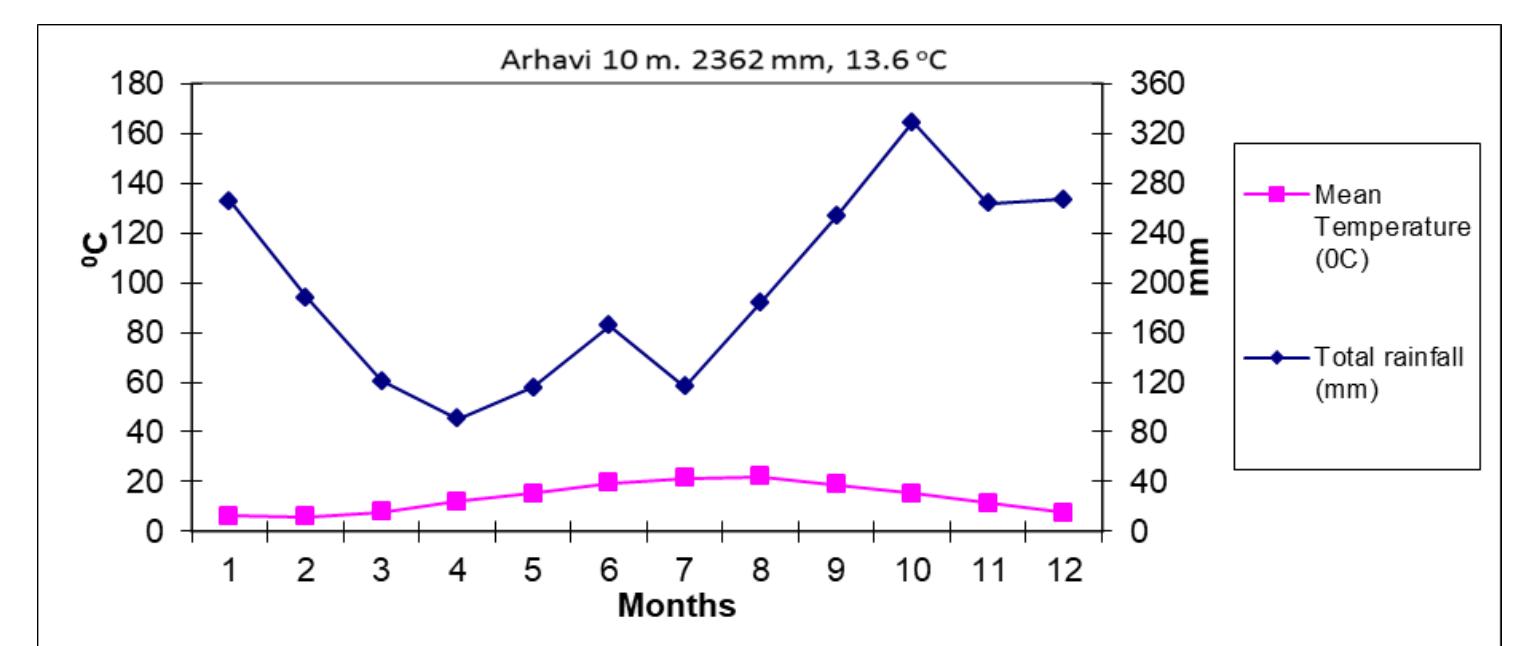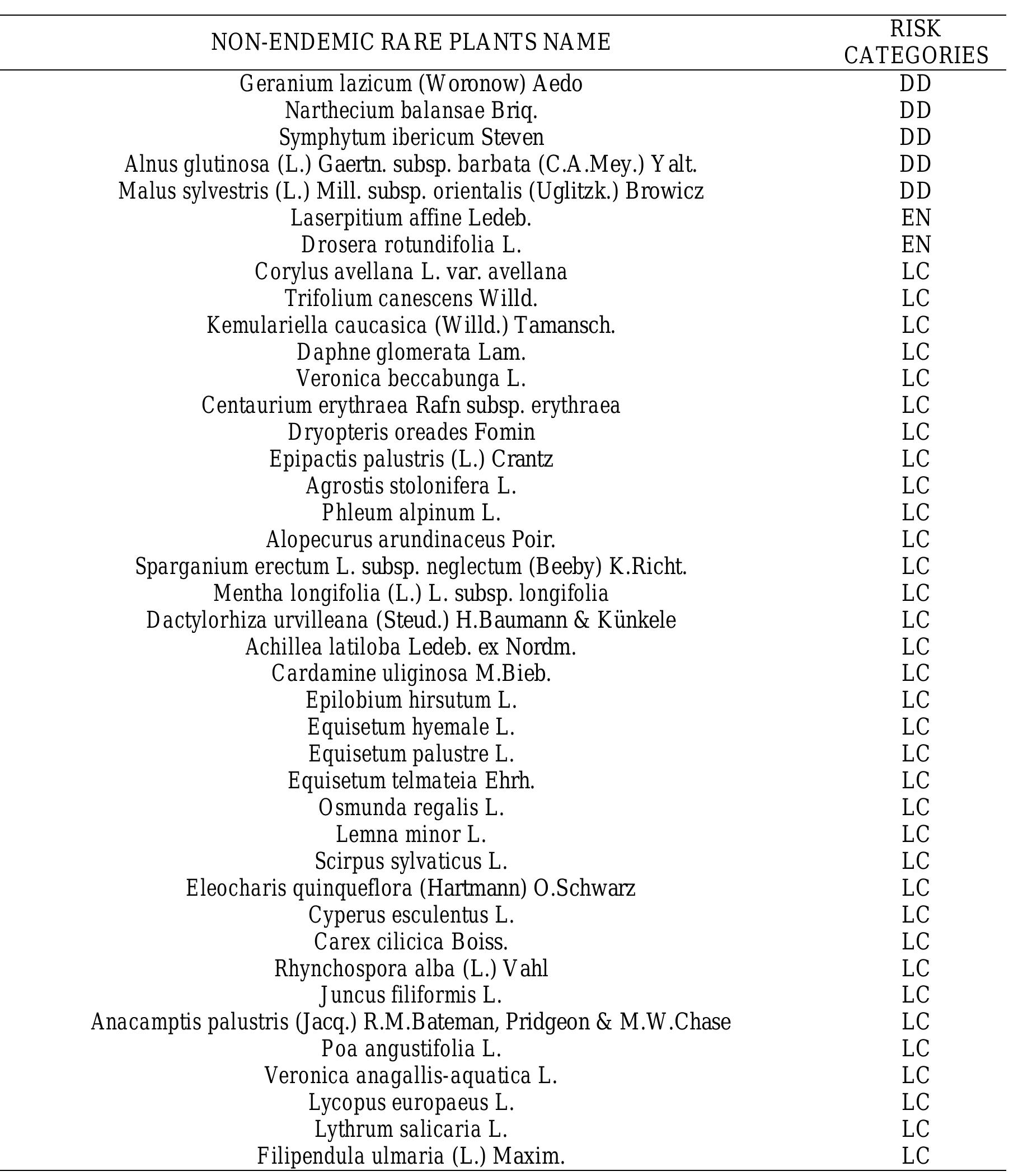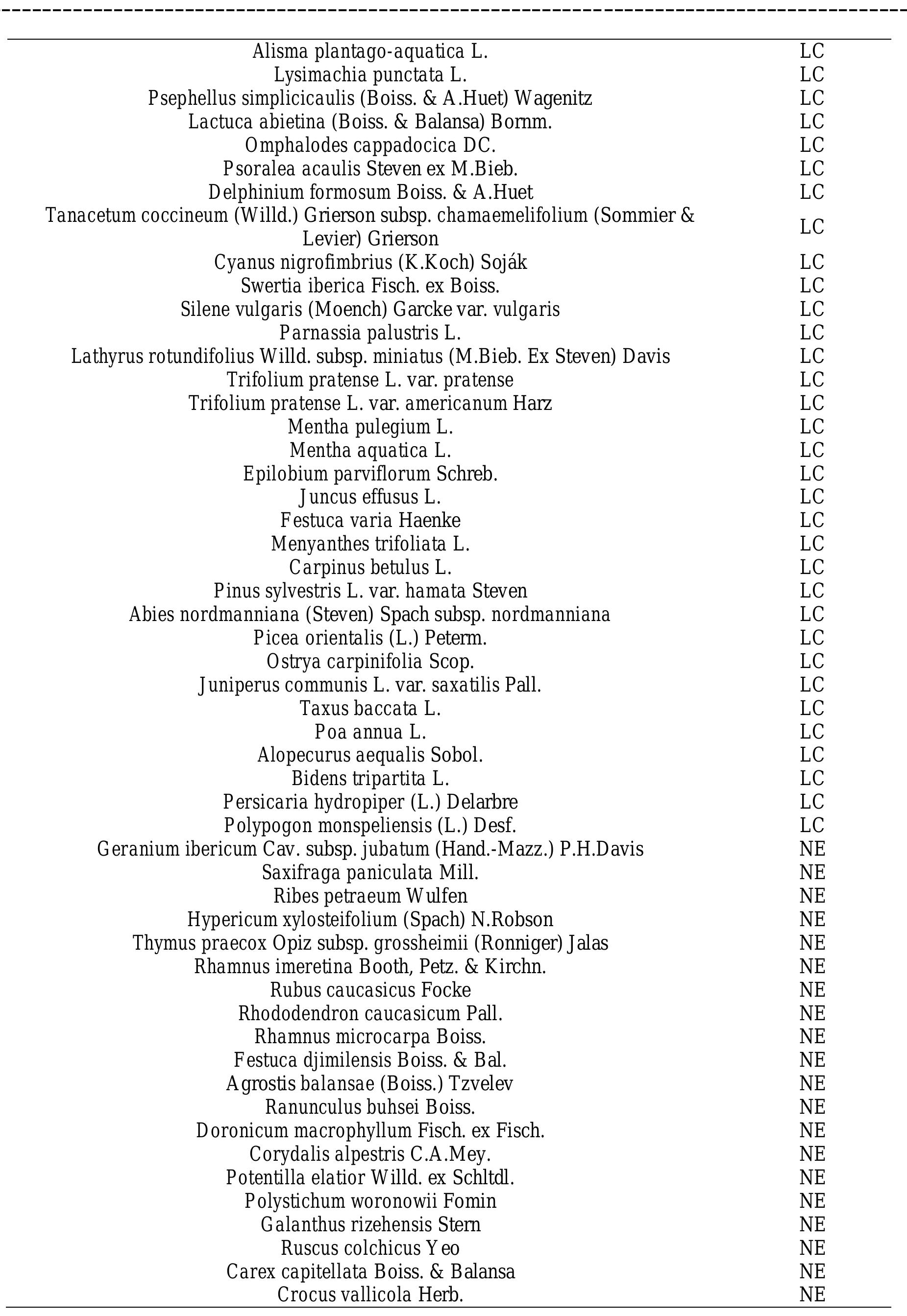FLORA OF THE KAMILET VALLEY (ARHAVI, ARTVIN, TURKEY) (original) (raw)
2017, International Journal of Ecosystems and Ecology Sciences-IJEES
Abstract
This study has been carried out for determination and contribution to the flora of Kamilet Valley where has quite rich floristic composition during 2011-2016. The research area under review is taken place in Colchic province of Euro-Siberian floristic area of Holarctic and is found in the A8 square according to grid system of Davis. On the other hand, the study area lies between 300 and 3264 m. elevation above the sea level. In this study, total 651 plant taxa belong to 107 families and 361 genera were determined. 41 of them belong to Pteridophyta, the remaining 610 taxa were Spermatophyta which included 5 taxa from Gymnospermae and 605 taxa from Angiospermae. Angiospermae also included 504 taxa from Dicotylodonae and 101 taxa from Monocotyledonae. The largest families recorded were as follows: Asteraceae 79 taxa, Poaceae 44 taxa, Rosaceae 38 taxa, Fabaceae 30 taxa, Brassicaceae 28 taxa, Lamiaceae 28 taxa, Caryophyllaceae 21 taxa, Ranunculaceae 20 taxa, Boraginaceae 18 taxa and Apiaceae 17 taxa. The percentage of phytogeographical origins of 378 taxa (%58.07) was determined. The distribution of the taxa according to the phytogeographical regions was as follows: 326 taxa (86.24%) Euro-Siberian, 19 taxa (5.03%) Irano-Turanian, 5 taxa (1.32%) Mediterranean, 28 taxa (7.41%) cosmopolit. The life form spectrum of the taxon was as follows: Hemicryptophytes 253 taxa, Cryptophytes 196 taxa, Phanerophytes 46 taxa, Chamaephytes 68 taxa, Therophytes 86 taxa and Vascular Parasites 2 taxa. Endemism is 2.92% and included 19 endemic taxa. The endemic and rare non-endemic plants in the study area have been indicated to IUCN threat catagories.
Figures (10)
Figure 1. Topographical map of the study area. within the Colchic province of the Euro-Siberian floristic area in the Holarctic region (Zohary, 1973). The altitude of the area is between 300 and 3264 m. The area under review has a length of 41 km and extends from the Cifte Kemer Bridge (170 m) to Alacagol Plateau (3264 m). The study area includes a sharp valley water catchment area that has about 3000 m elevation differences. The area is situated between lat 41°15’53’’ — 41°08’13’’ N and long 41°21’51”’- 42°25’07’’ E and is some 7634 ha in area (Figure 1). Climatological data were obtained from Arhavi Meteorological station. The annual average rainfall is 2362 mm and the average warmth is 13.6 °C in the area (DMi, 2015). The coldest month is February, with a minimum temperature of —9.1 °C, and the hottest month is June, with a maximum temperature of 35.0 °C. The climatic diagram was prepared using Walter’s method (Figure 2). The rainfall regime of the study area is “autumn-winter-summer-spring” of semi-terrestrial origin (Walter, 1956; Akman, 1999). The geological structure of the research area mostly contains rocks belonging to the Upper Cretaceous period. There are 2 large soil groups in the study area, namely, red-yellow podzolic soils and high mountain meadow soils. (URL 3). Forest, alpine, subalpine, rocky, and hydrophytic are the main vegetation types in the study area. Forest vegetation is the most widespread in the study area.
Table 1. The dispersion of taxa into large taxonomical groups. The vascular plant flora of the Kamilet Valley is represented by 651 taxa, 641 species, 94 subspecies, and 27 varieties belonging to 361 genera and 107 families. Most of them belong to Spermatophyta (610 taxa) and the remainder belong to Pteridophyta (41 taxa). Gymnosperms and Angiosperms comprised 5 and 605 taxa, respectively. Of the Angiosperms, 504 taxa are Dicotylodonae and 101 taxa are Monocotyledonae. The dispersion of the plant taxa that were defined in the study area according to large taxonomical groups is shown in Table 1.
Figure 2. Climatic diagram of Arhavi
Table 2. The phytogeographical spectra of the taxa (%) in this study and other studies. The Euro-Siberian elements seem to be dominant in all areas studied and the Irano-Turanian elements come second. The representation of Irano-Turanian taxa shows the effects of continental climate and the transitional character of the study area. In some local regions (i.e. along the stream banks) a minor number of Mediterranean taxa occurred. A comparison of families in terms of the largest number of species found in this study and to previous studies carried out in nearby regions is given in Table 3. As seen in Table 3, the results of this article were also in agreement with the other similar studies. Differences in several taxa might be derived from the results of dissimilarities in climate and habitat. The main reason for the low endemism ratio observed in this study is the climatic and environmental similaritie: between Caucasian flora and the study area. Similar results were obtained from other floristic studies in the Easterr Black Sea region of Turkey (Duzenli, 1979; Angin, 1980; Giiner, 1983; Giiner et al., 1987; Kiiciik, 1998 Eminagaoglu & Angin, 2003; Eminagaoglu et al., 2007) (Table 2). One of the most important causes of the low endemism rate in the study area was the occurrence of tree species in higher parts. As a result, species diversity wa: decreased due to decreasing resource availability, particularly the amount of light, and the fact that areas compatible for endemic species were narrowed. Especially at higher elevations, herb species were lacking and they were outcompeted by tree species (Kikvidze & Ohsawa, 2001; Yalcin et al., 2004). Hemicryptophytes prevailed in oper physiognomies, whereas the phanerophytes were the best represented class in the closed ones (Batalha & Martins 2004).
Table 3. Comparison of the 10 families containing the most species in studies conducted in nearby regions (%). (10), Apiaceae (15), Lamiaceae (15), Brassicaceae (13), Ranunculaceae (13), Boraginaceae (12), Caryophyllaceae (10). The richest families in terms of number of taxa were Asteraceae (79), Poaceae (44), Rosaceae (38), Fabaceae (30) Brassicaceae (28), Lamiaceae (28), Caryophyllaceae (21), Ranunculaceae (20), Boraginaceae (18), Apiaceae (17). The total ratio of the 10 major families is 49.6%, with the remaining families comprising 50.4%. The major family order in our study is concordant with the Flora of Turkey (Guner et al., 2000). A comparison of families in terms of the largest number of species found in this study and in previous studies carried out in nearby regions is given ir Table 3. The results of this study are in agreement with those of other similar studies (Duzenli, 1979; Guner, 1983, Guner et al., 1987; Kucuk, 1998; Eminagaoglu & Angin, 2003; Eminagaoglu et al., 2007). Differences in several families might be due to the results of dissimilarities in climates and habitats. Asteraceae (the largest family in ow list) is not only the largest family in the Flora of Turkey (Guner et al., 2000), but also the largest and mos widespread family of flowering plants in the world (Good, 1974). The richest genera in terms of the number of taxa were Geranium (10), Cardamine (9), Poa (9), Veronica (9) Campanula (8), Carex (8), Dryopteris (8), Hypericum (8), Trifolium (8), Asplenium (7). Pseudomacchie, forest, subalpine, alpine and stream are the main vegetation types in the area. Forest vegetation is the most common formation type in this area. In conclusion, the study area is mainly under the influence of a semi. hiimid climate which ie aitahla far arnnwing Burm-CSihanan Fiyine Uvrerann-Fiyvina and Colchic alamante
Appendix 1: IUCN risk categories of endemic taxa in research area:
A ppendix 2: IUCN risk categories of non-endemic rare plants in the research area
Acknowledgements. The authors thank to Artvin Coruh University Scientific Research Projects Coordinator (Project No: 2011.F 10.01.04) for their financial support.

Loading Preview
Sorry, preview is currently unavailable. You can download the paper by clicking the button above.
References (41)
- Akman Y, (1999) İklim ve Biyoiklim (Biyoiklim Metodları ve Türkiye İklimleri), Kariyer Press, Ankara, 350 p;
- Anşin R, (1979) Trabzon-Meryemana Araştırma Ormanı Florası ve Saf Ladin Meşcerelerinde Floristik Araştırmalar, Karadeniz Gazetecilik ve Matbaacılık Press, Trabzon, 234p;
- Anşin R, (1980) Doğu Karadeniz Bölgesi Florası ve Asal Vejetasyon Tiplerinin Floristik İçerikleri, Doçentlik Tezi, KTÜ Orman Fakültesi, Trabzon. 220p;
- Anşin R, (1983) Türkiye'nin Flora Bölgeleri ve Bu Bölgelerde Yayılan Asal Vejetasyon Tipleri (The Floristic Regionsand the Major Vegetation Types of Turkey), KTÜ Orman Fakültesi Dergisi, 6, 2, pp. 318-339;
- Anşin R, (1984) Artvin-Atila (Hatila) Vadisinin Bitki Örtüsü ve Bu Örtünün Filogenetik Özellikleri (Vegetation of the Atila Valley in Artvin Area and Its Fılogenetical Features), KTÜ Orman Fakültesi Dergisi, 7, 1, pp. 84-89;
- Batalha MA, Martins FR (2004) Floristic, frequency, and vegetation life-form spectra of a Cerrado Site. Braz J Biol 64: pp. 203-209;
- Davis PH (ed), (1965-1985) Flora of Turkey and the East Aegean Islands. Vols. 1-9. Edinburgh University Press, Edinburgh;
- Davis PH, Harper PC, Hedge IC, (1971) Plant Life of South West Asia, The Botanical Society of Edinburg;
- Davis PH, Mill RR, Tan K, (eds), (1988) Flora of Turkey and the East Aegean Islands. Vol. 10. Edinburgh University Press, Edinburgh;
- DMİ, (2015) Artvin Meteoroloji Müdürlüğü 1970-2015 Yılları Arası Arhavi ve Hopa İlçesi İklim Verileri;
- Düzenli A, (1979) Tiryal Dağı'nın (Artvin) Bitki Sosyolojisi ve Bitki Ekolojisi Yönünden Araştırılması, TÜBİTAK, TBAG-256, Ankara;
- Düzenli A, (1988) Neuve aux Sintaxons Phytosociologies pour la Végétation de Turquie. Ecol Med 14: pp. 143-148;
- Ekim T, Koyuncu M, Vural M, Duman H, Aytaç Z, Adıgüzel N, (2000) Türkiye Bitkileri Kırmızı Kitabı, Eğrelti ve Tohumlu Bitkiler (Red Data Book of Turkish Plants, Pteridophyta and Spermatophyta), Barışcan Ofset, Ankara, 246; Ekim T, Terzioğlu S, Eminağaoğlu Ö, Coşkunçelebi K (2014) Turkey. In: J. Solomon, T. Schulkina & G.E. Schatz (editors), Red List of the Endemic Plants of Caucasus: Armenia, Azerbaijan, Georgia, Iran, Russia, and Turkey. Monographs in Systematic Botany from the Missouri Botanical Garden (MSB) 125. Missouri Botanical Garden Press, Saint Louis;
- Eminağaoğlu Ö (Ed.), (2015) Artvin'in Doğal Bitkileri. Promat, İstanbul, 456p;
- Eminağaoğlu Ö, (2009) The Plant Diversity of Tekkale-Çevreli and Cemketen Villages (Yusufeli, Artvin), Bulletin of Batumi Botanical Garden, 33, pp. 152-159;
- Eminağaoğlu Ö, Anşin R, (2002) A9 (Artvin) Karesi İçin Yeni Floristik Kayıtlar, Kafkas Üniversitesi Artvin Orman Fakültesi Dergisi 3, pp. 96-108;
- Eminağaoğlu Ö, Anşin R, (2003) The Flora of Hatila Valley National Park and its Close Environs (Artvin), Turkish Journal of Botany, 27, pp. 1-27;
- Eminağaoğlu Ö, Anşin R, (2004) Flora of The Karagöl-Sahara National Park (Artvin) and Its Environs, Turkish Journal of Botany, 28, pp. 557-590;
- Eminağaoğlu Ö, Anşin R, (2005) The Flora Of Cerattepe Meydanlar Demirci Gavur Creek And Near Environment In Artvin, İstanbul Üniversitesi Orman Fakültesi Dergisi, 55 (2), pp 31-46;
- Eminağaoğlu Ö, Yüksek T, Gümüş S, Kurdoğlu O, Eraydın S, (2007) Borçka-Karagöl Tabiat Parkı ve Çevresinin Flora ve Vejetasyonu, TÜBİTAK Projesi, No:103 O 079 (TOGTAG-3210), Project Final Report;
- Erik S, Güner A, Yıldırımlı Ş, Sümbül H, (1996) Tohumlu Bitkiler Sistematiği Laboratuvar Kılavuzu. Ankara: Literatür Yayınevi Press, 165 p;
- Good R (1974) The Geography of the Flowering Plants. Fourth Edition.London: Longman Group Limited;
- Grosheim AA, (1939-1967)
- Flora Kavkaza, Ciltler 1-7, Bakü ve Leningrad;
- Güner A, (1983) Kaçkar Dağlarının Kuzey Yamacının Florası, TÜBİTAK, TBAG-463, Ankara;
- Güner A, Vural M & Sorkun K, (1987) Rize Florası, Vejetasyonu ve Yöre Ballarının Polen Analizi, TÜBİTAK, TBAG-650, Ankara;
- Güner A, Özhatay N, Ekim T, Başer KHC, (2000) Flora of Turkey and the East Aegaen Islands, Vol. XI, Supplement -II, Edinburgh University Press, Edinburgh;
- Güner A, Aslan S, Ekim T, Vural M, Babaç MT, (edlr.), (2012) Türkiye Bitkileri Listesi (Damarlı Bitkiler). Nezahat Gökyiğit Botanik Bahçesi ve Flora Araştırmaları Derneği Yayını. İstanbul;
- IUCN, (2017) The IUCN Red List of Threatened Species. Version 2017-2. http://www.iucnredlist.org. Downloaded on 14 January 2017;
- Ketzkhoveli NN & Gagnidze RI (eds.) (1971-2001). Georgian Flora (Flora of Georgia). Vols. 1-13. Metsniereba, Tbilisi, Georgia;
- Kikvidze Z, Ohsawa M, (2001). Richness of Colchic vegetation: comparison between refugia of south-western and East Asia. BMC Ecol. 116: 1-10;
- Komarov VL, (1934-78) Flora of the U.S.S.R., Vol. 1-30, Israel Program for Scientific Translations, Jerusalem.
- Küçük M, (1998) Kürtün (Gümüşhane)-Örümcek Ormanlarının Florası ve Saf Meşcere Tiplerinin Floristik Kompozisyonu, DKOA Yayın No:5, Trabzon;
- Özhatay N, Byfield A, Atay S, (2003) Türkiye'nin Önemli Bitki Alanları (Important Plant Areas of Turkey). istanbul: WWF Turkey. 88;
- Özhatay N, Byfield A, Atay S, (2005) Türkiye'nin 122 Önemli Bitki Alanı, WWF Turkey. İstanbul, pp. 476. URL-1. http://www.ipni.org (accessed 20 May 2016);
- URL-2. http://www.theplantlist.org (accessed 20 May 2016);
- Vural M, (1996) Rize'nin Yüksek Dağ Vejetasyonu, Tr. J. of Botany, 20, pp. 83-102.
- Walter H, (1956) Kurak Zamanların Tesbitinde Esas Olarak Kullanılacak Klimogram, (Çev. S.Uslu), İÜ Orman Fakültesi Dergisi, Seri B, 8, 2.
- WWF & IUCN (1994) Centres of Plant Diversity. A Guide and Strategy for Their Conservation. Vol. 1. Cambridge: IUCN Publications Unit, UK.; Yalçın E, Bilgin A, Kutbay HG, Kılınç M (2004) Relationships between community structure and soil properties of a swamp forest from Northern Turkey. Pol J Ecol. 52: pp. 233-238;
- Zazanashvili N, Sanadiradze G, Bukhnikashvili A (1999) Caucasus. In: RA Mittermeier, N Meyers, P Robles Gil, and CG Mittermeier. Hotspots: Earth's Biologically Richest and Most Endangered Terrestrial Ecoregions. pp. 268- 277. Mexico: CEMEX;
- Zohary M, (1973) Geobotanical Foundations of the Middle East, Vol. I-II, Gustav Fischer Verlag, Stutgart;









